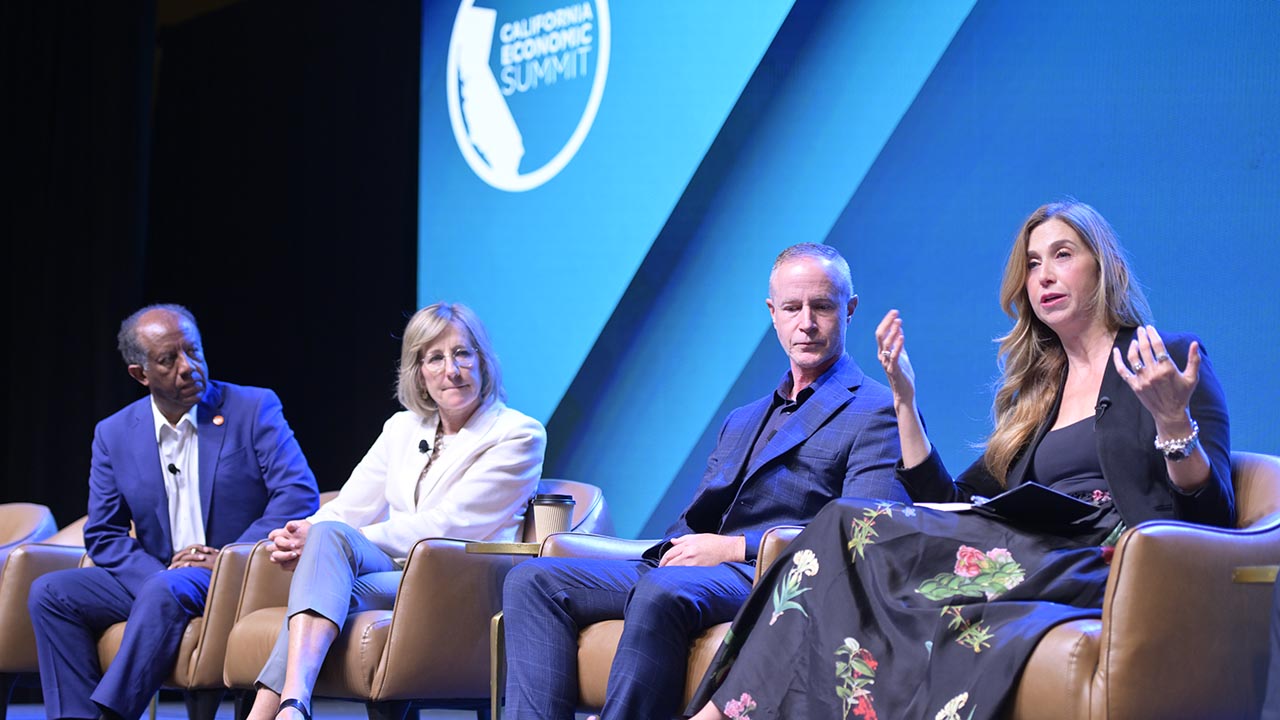
Gayle Miller (right), chief deputy director of policy at the California Department of Finance, speaking on the infrastructure panel Thursday at the 2023 California Economic Summit, along with, Stewart Knox, secretary of the California Labor & Workforce Development Agency, Dee Dee Myers, senior advisor to the Governor and director of the Governor’s Office of Business and Economic Development (GO-Biz), and Samuel Assefa, director of the Governor’s Office of Planning and Research (Photo: Roger Morales Photography/CA FWD)
The 2023 California Economic Summit kicked off this morning in Indian Wells as nearly 900 policy and thought leaders gathered to advance work toward making California a more equitable, sustainable and prosperous state. CA FWD’s interim CEO Ismael Herrera opened the Summit with Indian Wells Mayor Donna Griffith and bird singers from the Agua Caliente band of Cahuilla Indians.
CERF Rebrands to Jobs First
The Community Economic Resilience Fund (CERF), which grew from the work of the Summit, has rebranded to California Jobs First. According to Dee Dee Meyers, senior advisor to the Governor and director of the Governor’s Office of Business and Economic Development (GO-Biz), this signals an evolution to California’s signature regional economic development program. “Not only did we want to rebrand CERF, we wanted to bring together the work in this area more broadly.” She cited workforce development, education, economic development investments that drive toward the goal of creating an economy that works for every Californian.
“What we learned over the last two years is that people on the ground actually charting their own path around economic development is that that is what true equity means, which is to listen the people who are actually doing the work,” said Samuel Assefa, director of the Governor’s Office of Planning and Research.
Those on the ground are the regional conveners who discussed the importance of collaboration and other innovative practices to ensure communities traditionally left behind are involved in the process. Yolanda Meraz, chief strategy officer of Stanislaus Equity Partners CDC, talked about their CERF School, a curriculum for the collaborative. “They can become experts in the region so the youth that represent rural Patterson feels equipped and empowered to make decisions for the entire region, so they’re familiar with the entire region.”
Other regions, such as in Orange County where there are using technology to meet stakeholders where they are. That includes utilizing online tools conduct and post meetings as well as administer online polls. In Kern County, Jessica Grimes, associate vice chancellor for career education and workforce development for the Kern Community College District discussed the importance of language inclusivity. “It’s not only been about contracting community based organizations that are linguistically diverse, but also providing the education and building this understanding that shared so that people are able to come to that table.”
California Invests in Infrastructure
Earlier this year, the state unveiled an ambitious infrastructure report detailing actions that could accelerate the delivery of up to $180 billion worth of infrastructure projects to promote equity, environmental sustainability and economic growth in the state. A big component of the infrastructure plan is workforce development as the plan estimates 400,000 workers will be needed over the next five to ten years to complete projects across the State. Stewart Knox, secretary of the California Labor & Workforce Development Agency, addressed that issue, saying “Our job at the labor agency is to really think about how the alignment of how the construction and all the work around CHIPs and hydrogen and everything else – how do we align that with our trade unions, our training councils, with our local communities.”
Gayle Miller, chief deputy director of California’s Department of Finance, describes what a successful infrastructure plan could mean for California. “The best conversation I’ve had with the governor on what it means to rebuild California’s future is that if we do this right, if we deliver, it actually proves democracy works. It’s the connection between actually delivering the jobs equitably in these communities and making this is more livable state.”
Creative Economy Debuts on Plenary Stage
The recent writers’ strike and the ongoing actor’s strike has underscored the importance of the creative economy to California, a $260 billion industry that is 14.9% of the state’s economy. This year, the creative economy made its debut on the Summit plenary stage. “Art work is real work,” said Kristen Dolan, executive director of the California Desert Arts Council, which distributed $110 million to arts organizations in the Coachella Valley. “When you think about that, we are economic drivers and by excluding us or not paying attention, money will be left on the table.”
Senator Anthony Portantino (D-Glendale) noted that supporting individual artists as well as the industry as a whole is important. “There are people who have this creative instinct, we should channel it and the way to help channel it is to continue to make it economically viable for that creativity.” He sponsored SB1116, which was signed into law to establish the Equitable Payroll Fund for the nonprofit arts sector to create jobs and revitalize local economies. “The more we support the arts, the more we live a more healthy life.”
The 2023 California Economic Summit continues this afternoon and will conclude tomorrow.

